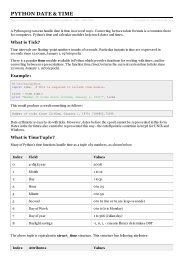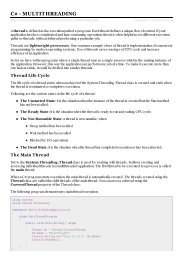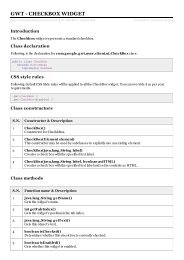Tutorials Point, Simply Easy Learning
Tutorials Point, Simply Easy Learning
Tutorials Point, Simply Easy Learning
Create successful ePaper yourself
Turn your PDF publications into a flip-book with our unique Google optimized e-Paper software.
24 | P a g e<br />
<strong>Tutorials</strong> <strong>Point</strong>, <strong>Simply</strong> <strong>Easy</strong> <strong>Learning</strong><br />
For orders the values are 12, 32, and 40 which implies that the objects are having these values<br />
for the particular moment (here the particular time when the purchase is made is considered as<br />
the moment) when the instance is captured.<br />
The same is for special order and normal order objects which are having number of orders as<br />
20, 30 and 60. If a different time of purchase is considered then these values will change<br />
accordingly.<br />
So the following object diagram has been drawn considering all the points mentioned above:<br />
UML Component Diagram<br />
Component diagrams are different in terms of nature and behaviour. Component diagrams are<br />
used to model physical aspects of a system.<br />
Now the question is what are these physical aspects? Physical aspects are the elements like<br />
executables, libraries, files, documents etc which resides in a node.<br />
So component diagrams are used to visualize the organization and relationships among<br />
components in a system. These diagrams are also used to make executable systems.<br />
Purpose:<br />
Component diagram is a special kind of diagram in UML. The purpose is also different from all<br />
other diagrams discussed so far. It does not describe the functionality of the system but it<br />
describes the components used to make those functionalities.<br />
So from that point component diagrams are used to visualize the physical components in a<br />
system. These components are libraries, packages, files etc.<br />
Component diagrams can also be described as a static implementation view of a system. Static<br />
implementation represents the organization of the components at a particular moment.<br />
A single component diagram cannot represent the entire system but a collection of diagrams are<br />
used to represent the whole.<br />
So the purpose of the component diagram can be summarized as:<br />
� Visualize the components of a system.<br />
� Construct executables by using forward and reverse engineering.<br />
� Describe the organization and relationships of the components.

















